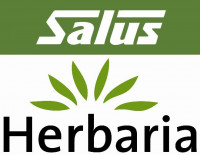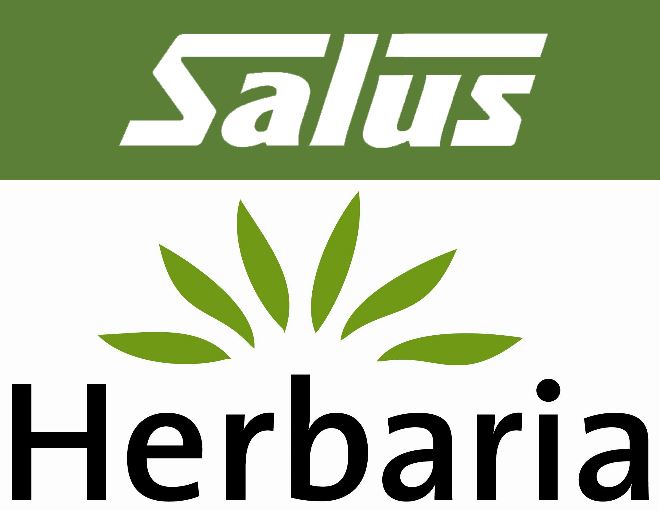| Quantity | Unit price | Reference price |
|---|---|---|
| To 5 | €18.95 * | €37.90 * / 1 l |
| From 6 | €17.95 * | €35.90 * / 1 l |
*prices incl. VAT plus shipping costs
Ready to ship today,
Delivery time appr. 1-4 days²
- Order number: 600003
- best before: 31.05.2025
- EAN: 4004148057274
- advice: Do not store above 25 °C. The bottle must be closed immediately after use and stored in the refrigerator. Keep medicines out of reach of children. Shelf life after opening: 4 weeks.
Herbal blood Floradix for the prevention of iron deficiency, in case of increased need for iron
Herbal special tonic with organically bound iron, fruit juices and medicinal herbs
over-the-counter medicine
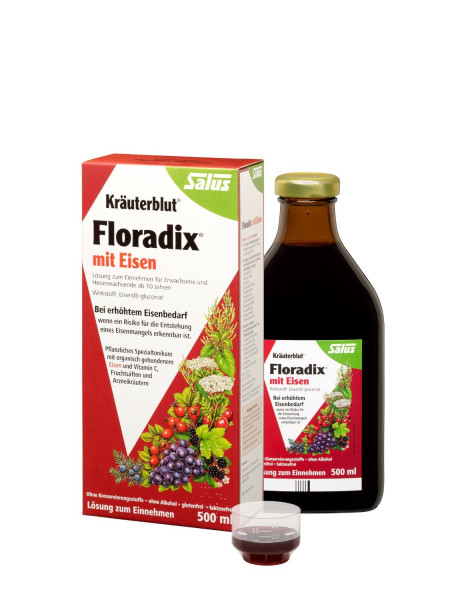
Fresh blood and new strength!
Millions of people lack blood-forming iron. If the organism is to perform at its best, it needs sufficient iron. Since the body does not produce iron itself, a sufficient supply of this vital element is necessary.
Herbal Blood Floradix is especially indicated in the following situations:
- Paleness and fatigue - the cause is often iron deficiency
Since our food usually does not contain sufficient amounts of iron, it is easy to develop deficiency symptoms, which can manifest themselves in fatigue, reduced performance, lack of stamina, headaches, numbness of hands and feet, rough skin, pale appearance, nail grooves and brittle hair. In order to properly replenish the body's iron depot, a course of treatment with a good iron supplement such as Floradix® with iron should be carried out from time to time. - Particularly at risk: Women and girls
Almost every second girl and every second woman today have too little iron in their blood. The reasons for this are menstrual bleeding, pregnancy as well as breastfeeding periods, which reduce the existing iron depot. - Schoolchildren and adolescents need a lot of iron
At growing age, a particularly large amount of iron is needed for the build-up of blood pigment and the growth of the body's cells. - Diet cures
Here too, Floradix® with iron has proven its worth as a natural supplement to the iron requirement in diet diets. - Vitality in old age
In people in the second half of life, the normal absorption of iron through the intestines may be reduced. One then often feels listless and tired.
The bivalent iron of Floradix® with iron promotes blood formation. The natural remedy Floradix® with iron with 750 mg iron per 1000 g was developed through intensive research. With Floradix® with iron you receive a drug that meets the latest scientific requirements and has been tested many times. Fruit juices complement the proven formula and contribute additionally to the digestibility.
Recommendation: so that Floradix® with iron can achieve the desired positive effect, it should be taken at least 2 ½ months.
The special Schafi-Shop service: guaranteed freshness of your desired product!
With other online stores, whether Amazon, Internet pharmacy, manufacturer store or marketplaces, you can guess how long the product will keep. But it is important to know how fresh the product is that you want to order. And it is very important to know whether you can order one piece or a whole carton in stock. At Schafi-Shop there is no guesswork, we also show you for each product with best before date ("MHD") exactly the day until which it is durable, if you order at the exact moment when you click on "buy now". This is the Schafi-Shop transparency on freshness and quality. Always available and reliable.
Why does only Schafi-Shop offer this? With our newly introduced computer platform, we gave our software provider exactly this task: we want to have the MHD available everywhere. Not only did this cost a lot of money once, we have to record the exact date until which it is best before for each delivery from the manufacturer for the respective quantities. And these must then be stored in separate shelf locations in our Schafi logistics. And the Schafi employees who pack your order have to be sent to the storage locations determined by our software so that exactly these items also find their way into your package. This all costs time and is additional work for all Schafis. Only we are sure: You want to know which MHD you will receive. You want to be sure that you receive the freshest products. That's why we gladly invest the extra time needed every day anew, because we know how important this information is to you.
With this in mind: welcome to your transparent Schafi Fresh Shop!
Highest quality, safe storage and optimal handling of organic products and over-the-counter medicines in the Schafi-Shop
Unfortunately, there are many traders who do not comply with the conditions for selling organic products and over-the-counter medicines. These traders simply save training, certifications and registrations and thus commit violations of laws, regulations and violate fairness in competition. Such customers are at risk of having products that are not in proper condition due to lack of expertise and can risk the health of customers. It is very important to the Schafis that you get the best products and the best service in the Schafi Shop also because we comply with all certifications, trainings and registrations at all times. Here is an overview:
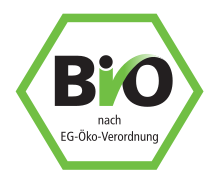 | 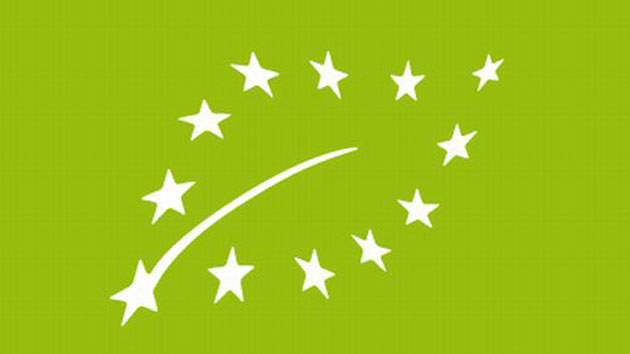 | 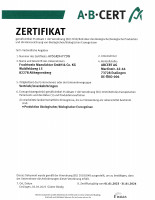 | |
| Registered at DIMDI and | National organic seal | EU organic seal | Schafi-Shop certificate** |
*Schafi-Shop is registered with the German Institute for Medical Documentation and Information (DIMDI) upon application to the regional supervisory authority, the District Office Fürstenfeldbruck, Hans-Sachs-Str. 9, 82256 Fürstenfeldbruck. This is done on the basis of the enforcement of the German Medicines Act (AMG). With a mouse click on the displayed logo, the customer is shown the name and further details of the distributor, which are stored at DIMDI. This allows customers to quickly and reliably check that Schafi-Shop has permission to sell. We have several Schafi employees who have proven expertise in handling these products (a successfully completed university degree with relevant examinations as well as a successfully passed IHK examination for the "Examination of expertise for the retail sale of over-the-counter medicines according to §50 of the German Medicines Act").
**Schafi-Shop, a brand of Fruchtwein Manufaktur GmbH & Co. KG, is regularly certified by an independent control institute as a retailer according to the EC Organic Regulation. Öko-Kontrollstelle DE-ÖKO-006, registration number according to EC Organic Regulation No. 834/2007: DE-BY-006-50203-H. You can get more information by clicking on the certificate or here.
| Füllmenge (Volumen): | 500 ml |
| drug: | Yes |
| health: | Minerals & Vitamins, Products for her, Products for him, Products for mothers |
| milk-free products: | Yes |
| age group: | from age of 6 |
| gluten-free products: | Yes |
| Shipping weight: | 0,991 kg |
| Manufacturer: | Herbaria, Salus |
| Made in: | EU (Germany) |
| product group: | Nutritional supplement / over-the-counter medicines |
| brand: | Salus |
| further properties: | gluten free, non-alcoholic, non dairy, over-the-counter medicines, without preservative substances |
| Manufacturer address: | SALUS Haus Dr. med Otto Greither Nachf. GmbH & Co. KG, Bahnhofstraße 24, 83052 Bruckmühl, Deutschland |
Manufacturer contact: Herbaria Kräuterparadies GmbH, Hagnbergstraße 12, 83730 Fischbachau, Germany / SALUS Haus Dr. med. med. Otto Greither Nachf. GmbH & Co. KG, Bahnhofstr. 24, 83052 Bruckmuehl, Germany
The Herbaria herbal paradise GmbH is one of the first suppliers of the health food scene and active founding members of the first federal association Naturkost Naturwaren e. V. (BNN). Even today, natural food stores and organic markets are among our main customers, but also the delicatessen, ecological re-processors and the gastronomy appreciate the high-quality Herbaria products for many years. Since February 2006, we have been one of the few providers of gourmet products in the organic sector that combine high-quality nutrition and high culinary demands with the "Organic Gourmet" spice line.
Well over 200 Herbaria products can be found nationwide in over 4,000 health food stores and health food stores. The medium-sized company currently has 27 employees, the management of Herbaria is in the hands of owner Otto Greither and Erwin Winkler (CEO).
It is very important for us to make consumers aware that the organic market is an individual rather than a mass market. We maintain relationships with smallholder producers in Germany, Europe and the rest of the world.
Herbaria: herbal knowledge since 1919
The company Herbaria was founded in 1919 as a herbal company for the production of remedies. Herbaria branded products in the field of remedies such as Eva Aschenbrenner's 6 tea, a wide range of herbal teas and Herbasana natural products are based on a long tradition and a great deal of experience, and can be found in all organic stores.
From 1981, the Herbaria supplies the first health food stores as a specialist for organic teas, herbs and spices. In 1987, the company became active as a founding member of the first federal association Naturkost Naturwaren e. V. (BNN) and continues to develop it to this day. The common concern is: "Healthy, wholesome and natural foods". The extremely strict guidelines of the association take into account not only the ecological cultivation, but also an environmentally friendly, careful and as little as possible processing of the raw materials.
Due to a steadily growing demand for the well-known and proven organic products from Herbaria, the Upper Bavarian company on Lake Schliersee needs more and more space. The move to Fischbachau at the foot of the Wendelstein in the larger premises of a former bread factory finally took place in 2000.
Active environmental protection
With the production of food and the purchase of organically produced products, we and our customers assume long-term responsibility for the nature and climate of our earth. We support sustainable forms of cultivation and processing that conserve natural cycles, conserve the resources of soil, water and energy and promote biodiversity.
quality
Our products bear the organic seal of the European Union. A proven, transparent and verifiable quality is thus the characteristic of our ecologically produced products. This includes, for example, the principal exclusion of irradiated or genetically modified raw materials and the complete abandonment of chemical preservatives. As co-founder and committed member of the Federal Association of Natural Food Natural Products e. V. (BNN), however, our company's strict quality criteria are far above the legal standards.
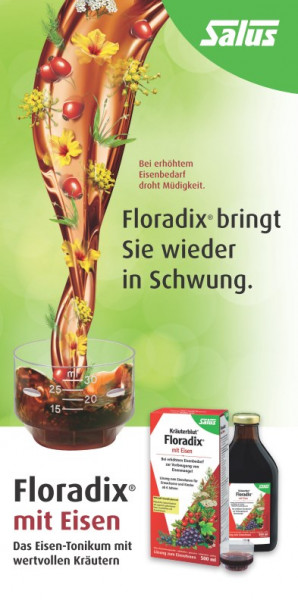
Composition:
100 ml (corresponding to approximately 109 g) of solution contains as active ingredient:
703.3 - 773.9 mg ferrous gluconate (Ph. Eur) corresponding to 81.75 mg ferrous ions.
Other ingredients:
Ascorbic acid, aqueous extract (1:28.2) of a mixture of hibiscus flowers, bitter fennel, carrot, couch grass, yarrow herb, angelica root, horsetail herb, ribwort leaves, juniper berries, chicory root, bitter orange peel (3:2,3:2,3:2,3:1.15:1.15:1,15:1,15:1:0.64), extractant water, yeast autolysate, grape juice concentrate red, cherry juice concentrate, pear juice concentrate, blackberry juice concentrate, black currant juice concentrate, honey, rose hip thick extract, fructose syrup 70%, orange flavor, orange flavor, water.
Floradix® with iron contains:
- 735 mg of ferrous gluconate in 100 ml corresponding to 81.75 mg of bivalent iron.
- Extract of digestibility-supporting and mineral-containing drugs:
Hibiscus flowers, bitter fennel, carrot, couch grass, yarrow herb, angelica root, horsetail herb, ribwort leaves, juniper berries, chicory root, bitter orange peel. - Vitamin C-containing fruit juice concentrates and extracts:
Grape juice concentrate red, cherry juice concentrate, pear juice concentrate, blackberry juice concentrate, black currant juice concentrate, rosehip thick extract.
Who needs Floradix
Floradix® for womenWomen are more likely to have increased iron requirements.Women of childbearing age are considered the main risk group for iron deficiency. Even in girls, the need for iron can increase after the onset of menstruation. A woman loses valuable iron month after month due to menstruation. This is because blood loss means iron loss. This must be compensated for by iron-rich food or an iron supplement .  Women need more ironWomen of childbearing age are considered the main risk group for iron deficiency. The focus is on pregnant and breastfeeding women. But even without pregnancy, women's iron balance is at risk. The body needs iron for cell and blood formation and for numerous metabolic processes, including energy production. The doctor can tell how the trace element is doing in the body from the blood values. The "serum ferritin" shows how full the stores are. From puberty onward, these values in women fall below those of male comparison persons. Menstruation, i.e. the cyclical loss of blood, takes its toll. About two-thirds of the body's iron is bound to the red blood cells, and the blood loss of a normal period averages 30 ml (= 15 mg iron) and remains constant for many years. Compensation is only possible through food. The body cannot produce iron itself. To ensure a balanced iron intake, menstruating women must take in about 15 mg of iron daily with meals. Even normal cyclical bleeding can often lead to a slight iron deficiency in women over the years. High iron requirements in certain phases of lifePregnant women also have an increased requirement due to the formation of new cells and blood for the child, blood losses during childbirth, and subsequent iron losses via breast milk during breastfeeding. In many cases, it is hardly possible to compensate for this with food alone. It can also become critical shortly before menopause, when menstruation is prolonged and particularly heavy due to hormonal changes. The hormonal ups and downs of puberty also often cause heavy bleeding. Because growth spurts with the formation of new cells and blood also drain iron reserves, young girls are at risk of developing an iron deficiency, especially if an unbalanced and reduced diet ensures little replenishment. Sources
|
Floradix® for fertilityIdeally, women replenish their iron reserves already at the beginning of family planning.Particularly increased demand for iron arises, for example, from increased menstruation or during pregnancy and lactation. Thus, it can make sense to pay attention to iron reserves even before pregnancy. In addition, folic acid is particularly important during pregnancy, as folic acid (folate) contributes to the growth of maternal tissue.  Folic acid even before pregnancyFolic acid and growth are closely linked. Therefore, women who want to have children and pregnant women should pay attention to the sufficient supply of the vitamin. In the body, the central task of folic acid is the formation of new cells and blood. Millions of cells are produced with its help every second: Cells for keeping the skin healthy and for hair growth, red blood cells for oxygen transport, white blood cells for defense against pathogens. Thus, the vitamin is also an integral part of the growth process, which is why an undersupply is especially critical during pregnancy. Folic acid deficiency increases the risk of malformations of the central nervous system and open back for the unborn child. Folic acid in foodAs vitamin B9, folic acid belongs to the group of B vitamins and is water-soluble. The natural form of the vitamin in food is called folate. The body cannot produce folic acid; it must absorb it through food. Sources include green vegetables such as leaf lettuce, spinach, chard, broccoli and other cabbage, parsley, legumes, bran, whole grains, nuts and egg yolks. Folic acid is extremely sensitive to heat as well as UV light and degrades rapidly as foods are stored, processed and cooked. Only what is very fresh, raw or gently cooked with little water and low heat will yield a good yield. Alcohol and also some drugs inhibit the absorption of folic acid in the intestine. Need and dietary supplementationMany people do not manage to cover the daily requirement of 300 micrograms of folic acid (pregnant women 400 micrograms) through their diet. If the supply is not assured, folic acid tablets are recommended as a supplement. Women who wish to have children are strongly advised to take folic acid. The combination with iron provides "double" security. Both folic acid and iron are important for the formation of new cells and blood. Sources
|
Floradix® in pregnancyDuring pregnancy, the need for iron increases by 100%.The trace element iron is important for blood formation, oxygen transport between mother and fetus and brain development of the unborn child. In addition, an iron depot is simultaneously created in the child for the first weeks of life. Ideally, women who wish to have children should replenish their iron reserves at the beginning of family planning. If an iron deficiency is diagnosed during pregnancy, the attending physician usually recommends taking an iron supplement.  Pregnant women need twice as much ironIron deficiency during pregnancy can severely disrupt the mother's well-being and the healthy development of the unborn child. Doctors advise replenishing iron stores early on, ideally as soon as the child is wanted. Almost every second pregnant woman in Europe develops an iron deficiency, especially in the second and last trimester. This entails risks for mother and child. The pregnant woman feels exhausted, is pale and listless. The heart is more stressed and the risk of infection increases. The children grow more slowly and are born with too little birth weight. The children's performance can be reduced, in some cases well into their school years, with learning and concentration deficits. Iron right from the startDoctors recommend targeting the trace element as early as the childbearing years. A diet rich in iron fills the stores. The best source is red muscle meat. Green leafy vegetables, legumes, whole grains and seeds also contain iron. However, the body is much less able to utilize plant-based iron. For pregnant women, supplemental early iron therapy is recommended. Simply taking iron "blindly" is not advisable. An overload can also put a strain on the pregnant woman and her child. The doctor uses the blood values to see how the stores are doing. The "ferritin value" (normal = 30-112 micrograms per liter) is informative. If necessary, iron supplements are recommended with the first pregnancy examination, but at the latest from the 13th week of pregnancy. This includes the breastfeeding period: Blood loss during childbirth depletes stores vigorously, and with milk production, the infant's iron needs must also be met. Sources
|
Floradix® during breastfeedingFor regeneration and breastfeeding, the body needs sufficient iron after birth.For wound healing, milk and new blood formation, the body needs sufficient iron during breastfeeding. With 20 instead of 15 milligrams per day, the requirement is still increased. Sometimes a healthy diet alone is not enough to cover such deficiencies. Doctors therefore recommend checking iron levels even after birth and, if necessary, taking countermeasures at an early stage with an iron supplement.  Iron supply during breastfeedingThe increased need for iron during pregnancy does not end with the birth. The body needs sufficient iron for regeneration and breastfeeding. Fit for the offspring with extra ironMothers with iron deficiency are tired and pale, sometimes short of breath. They have an increased risk of infections and puerperal fever and appear exhausted and depressed. Iron deficiency is considered a possible cause of "postpartum depression." The first weeks are not only very stressful for the mother, but also very important for early childhood development. A close mother-child bond with strength for closeness and security are important for healthy psychosocial development. This is an achievement that can be difficult for a weakened and depressed mother. Breastfeeding mothers also need a good supply of iron, because the newborn covers its needs through the mother's milk. An undersupply of iron to the child's brain risks developmental deficits with learning and concentration deficits until puberty. Sources
|
Floradix® for childrenIron supports the mental development of children.Children and adolescents may have increased iron requirements during their growth. Accompanying symptoms of growth can be fatigue, lower attention and less drive. In girls in particular, the need for iron can increase after the onset of menstruation. A figure-conscious diet additionally reinforces this. Iron also supports normal cognitive development and memory performance during times of high mental challenge.  When do children need more iron?Anyone who wants to grow big and strong needs iron. This is because the body needs plenty of vital substances and especially the trace element for growth as well as social and mental development. Meeting the iron requirements of children and adolescents is often not easy. The little ones refuse varied, healthy food until the parents capitulate and cook pasta with tomato sauce again. The older ones prefer fast food anyway. Those who have poor eaters at home should take a look at their iron supply. Children and adolescents in particular have an increased need for iron. The child's brain is developing rapidly. Around 86 billion nerve cells have to be formed, developed and networked in the first few years. Metabolism runs at full speed and messenger substances ensure coordination - all this is iron-dependent, even the provision of energy for it. The situation is similar with growth: The cell division necessary for this is iron-dependent, and iron, as a central building block of red blood cells, supplies the oxygen with which the body's cells produce their energy for this purpose. The trace element also quickly becomes a scarce commodity in young people. This can be due to strong growth, to the increase in blood volume or to the loss due to the onset of menstruation in girls. In addition, there is an unbalanced diet (fast food, sweets) or eating disorders. Not to be neglected are excessive amounts of "iron robbers" such as cola. The phosphates and tannic acids (tannins) in the soft drink form compounds with iron that are difficult to dissolve in the digestive tract - the organism excretes the trace element unused. When teenagers are tired, listless and irritable, hormonal changes are not always to blame. In some cases, their iron requirements are several times higher than those of adults. Many a "puberty symptom" turns out to be an iron deficiency symptom, with effects on school performance. Iron deficiency in children can show developmental deficits even years later, with delayed speech development and fine motor skills, difficulties with learning tasks, poorer social skills and attention deficits. Sometimes healthy food alone is not enoughThe basis for filled iron stores is a healthy diet. In the first months, this is the iron-rich breast milk. From the 6th month, the child's needs increase due to growth and mobility, and the iron content of breast milk decreases. Now meat containing food is recommended as a supplement . After that, a varied mixed diet is ideal: Lots of fruits and vegetables, meat, whole grains (bread, muesli), nuts, dairy products, sea fish and plenty of fluids. Meat is the best source of iron. The body can utilize the bivalent iron it contains well. The "trivalent iron" of plant foods, on the other hand, less so. A glass of orange juice (vitamin C) with the meal increases the yield. Teenagers, children and adolescents who are growing rapidly, who eat too little or not a balanced diet, or who are conspicuous by fatigue and declining performance, should have their iron levels checked by a doctor. Sources
|
Floradix® for athletesThe increased need for iron during sporting activities should not be underestimated.Those who often push their personal limits during sports also reach the limit of their iron reserves. In sports medicine, iron deficiency is a commonly diagnosed nutrient deficiency. Possible causes: Loss in particular due to microhemorrhages and an unbalanced diet. Female athletes are particularly often affected by the additional loss of iron during menstruation.  Athletes need more ironAlthough the body meticulously recycles iron, 1-2 mg is lost daily. In athletes, iron loss may even increase. The strain placed on the body by sport demands more oxygen and energy. More red blood cells and more myoglobin, the iron-containing oxygen suppliers of the muscle cells, are needed. If iron is lacking, the muscles can perform less. Muscle growth is also only triggered by myoglobin formation. Even carnitine, which transports fatty acids for energy production, can only be formed with iron as a cofactor. Particularly in endurance athletes, the increased formation of blood and myoglobin, as well as losses via sweat and micro-bleeding due to minute muscle tears, deplete supplies. The risk of slipping into deficit is high. The only source of replacement: food. However, special diet plans for athletes are not always rich in iron - for example, frequent pasta dishes or one-sided, low-calorie food for weight control. Those who forgo meat and opt for a purely vegan diet, for example, also reduce their iron intake as a result. Particularly in the case of a diet low in iron, athletes should pay attention to their iron supply at an early stage and consider taking a dietary supplement if necessary. Regular monitoring of iron levels by a doctor is particularly recommended for endurance athletes. This allows a poor iron balance to be detected early and the intake of iron can be adjusted before an iron deficiency develops. Sources
|
Floradix® for vegetarians and vegansFor vegetarians and vegans, it can be difficult to meet iron requirements.There are plant foods that contain iron, such as legumes, green vegetables, whole grains and nuts. However, the trace element contained in these foods (trivalent iron) is much more poorly utilized by the body, as it is difficult to dissolve in trivalent form and cannot be absorbed by the intestines in undissolved form. Our body can best utilize bivalent iron, since the bivalent form is water-soluble and can thus be absorbed by the intestine. If the daily need for iron can not be met, Floradix® iron plus B12 vegan is recommended. Because especially with a vegan diet, a supplementary supply of vitamin B12 is necessary, because it can not be available due to the renunciation of animal foods in the diet.  Vegetable food with much ironAn iron-rich diet is also possible without meat. However, since the body absorbs iron from plant foods more poorly, special attention must be paid to the preparation. In particular, nuts and seeds, legumes such as lentils and beans, and dried fruit are theoretically good sources of iron. However, it should be noted that the so-called trivalent iron from plant foods has a lower bioavailability than the divalent heme-bound iron found in meat. This means that the body cannot absorb the trivalent iron as well. This makes it all the more important to specifically promote the absorption of iron in a vegetarian or vegan diet. This can be done, for example, with vitamin C, fruit acid or lactic acid, which, when taken together with iron, can increase bioavailability. Substances that hinder absorption should not be consumed together with iron-rich foods. These include calcium, e.g. in dairy products, and tannins from coffee and black and green tea. There are also inhibitory substances in the plants themselves. For example, the German Federal Institute for Risk Assessment (BfR) recommends soaking or sprouting grains and legumes to reduce the content of phytates, which inhibit iron absorption. Preparation is also important. For example, cooking can result in losses. for example, 100 g of raw salsify contains an average of 3.3 mg of iron. After it has been cooked and drained, the value is only 2.9 mg on average. When switching to a purely plant-based diet, it is essential to ensure that the diet is sufficiently rich in iron. A doctor should regularly check the iron status so that it can be determined at an early stage whether supplementation with an iron supplement is necessary. Good plant sources of ironThe figures are the mean value for the edible portion per 100 g.
Source for all information on iron content in foods: Souci, Fachmann, Kraut: [The composition of foods, nutrition tables] Food composition and nutrition tables. Stuttgart, 2008 (7th, rev. and supplemented ed.). Sources:
|
Floradix® for the age group 50 plusWith increasing age, it makes sense to keep an eye on the iron supply.Iron deficiency becomes an issue especially in the second half of life, as symptoms such as fatigue and listlessness can aggravate existing complaints. In addition, the ability of the intestine to absorb iron decreases with age. It therefore makes sense to keep an eye on the iron supply.  Iron is particularly important from the age of 50When fatigue creeps in, concentration wanes, or the heart doesn't want to do its thing anymore, it's not always just age that's to blame. It could also be an iron deficiency. However, iron also has its "fingers in the pie" almost everywhere in metabolism. It is indispensable for the networking and communication of nerve cells in the brain, cell division to maintain health and contributes to hormone production. The body replaces damaged cells by dividing healthy ones from the neighborhood. This is how wounds are closed, how skin and mucous membranes keep their stressed surfaces healthy, how the heart recovers at night. If the trace element is lacking, the body has a harder time recovering and damage accumulates. The risk of infection also increases. The organization of defense against bacteria, viruses and fungi requires rapid division of immune cells. Less well tolerated in old ageIron deficiency becomes a particular issue in the second half of life because symptoms can exacerbate existing conditions. These include
Iron deficiency can additionally limit mobility and independence. The risk of infection increases, as does the risk of falling. Wound healing is poorer and eating is more difficult. Lack of drive makes it difficult to maintain social contacts. Dejection can turn into depression, and concentration and memory problems exacerbate dementia. It is particularly critical for weak hearts (cardiac insufficiency). Iron deficiency can increase the risk of complications. It therefore makes sense to keep an eye on the iron supply. In the event of a suspected deficiency, a family doctor can determine the iron levels in the blood count and, if necessary, recommend that take an iron supplement . Sources
|
Floradix® for seniorsEating iron-rich foods is often not so easy in old age.Changes in dietary habits and lack of appetite may be the reason for poor iron intake in old age. In addition, the normal absorption of iron by the intestines decreases with age. Last but not least, iron requirements also increase during the recovery period after illness or when taking certain medications. It is therefore essential to ensure an adequate supply of iron in the diet. If iron levels are poor, your family doctor can help.  Rich in vital substances through the best yearsAge often puts obstacles in the way of a healthy diet. For example, a lack of appetite or dental problems can make it difficult to absorb healthy substances through the diet. A varied and wholesome diet is particularly important at this time. But how to eat sufficiently healthy when the appetite decreases? The trick is to concentrate the nutrients without losing the pleasure. Whole grain porridge and finely flaked products with milk, yogurt and fruit are ideal as breakfast or snack, easy to swallow and digest. A "smoothie" contains two or three parts fruit and vegetables and can also be enhanced with mineral-rich herbs, valuable vegetable oils, whole grain flakes and a little honey. Where deficiencies in the diet threaten, for example selected nutrient preparations provide a balance. The metabolism is dependent on sufficient liquid - at least 1.5 liters daily. Because the feeling of thirst also diminishes in old age, it is helpful to set aside the amount in the form of water bottles in the morning. If you have impaired heart or kidney function, you should ask your doctor. Here, too much fluid can be harmful. In addition, the utilization in the body can be supported. For example, a glass of orange juice provides vitamin C and thus increases iron absorption. Fatty and sugary foods should be enjoyed in moderation. Due to the lower calorie requirement, it increases the risk of obesity and, as a consequence, diabetes and high blood pressure. Sources
|
Floradix® for iron deficiency anemia due to inflammationNot every body can absorb iron equally well.The body's iron metabolism is a fine set of rules. Iron therapy with drugs kicks in when not enough iron is absorbed or available in the diet to ensure iron needs are met and to prevent iron deficiency. However, increasing iron intake as needed does not always work. In such cases, it may be useful to focus on the metabolism and influence it to better utilize dietary iron. The protein lactoferrin can help to activate the biophysiological utilization of iron - especially when there is an inflammation-related iron deficiency.  What is Lactoferrin?Not everyone's body can absorb iron equally well. The protein lactoferrin can help activate iron utilization - especially when there is an inflammation-related iron deficiency. Swallow once and the iron begins its journey through the body. But whether it reaches where it is needed depends on many factors. Iron metabolism, which includes the transfer of ingested iron into the blood, is a finely tuned set of rules. Since the body has no possibility of excretion after absorption into the blood, it strictly controls the absorption. In principle, this process is favorable, because it ensures that only the required amount of the trace element from the food mush in the intestine also enters the blood. It becomes more difficult when inflammation occurs. This can happen, for example, if a high dose of iron is taken over a long period of time. In this case, and also in the case of an already existing inflammation, the transfer of iron into the blood is increasingly blocked - even if there is actually a need for iron. The following section explains how inflammation affects iron transfer and how lactoferrin can restore iron utilization: 1. Iron transfer from the intestine to the bloodIngested iron (labeled "Fe" in the graphic) enters the intestine through the normal digestive pathway. There, the iron transfer protein ferroportin ensures that dietary iron passes from the cells of the small intestine into the bloodstream. 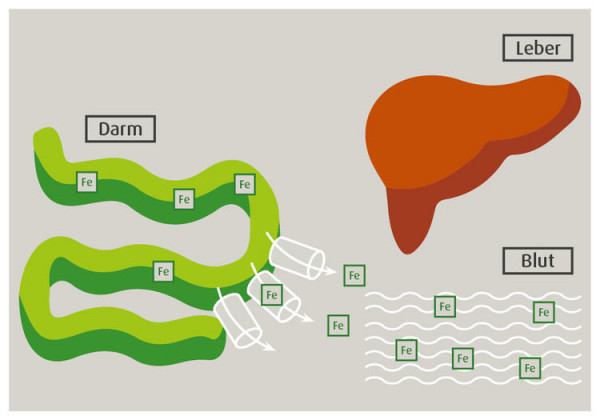 2. Effect of inflammationAs soon as we ingest iron, the liver begins to produce a peptide containing 25 amino acids. This small protein is called hepcidin. It regulates the level of iron in the blood, according to current knowledge. If the iron level in the bloodstream is high, the liver produces more hepcidin, which breaks down the iron transfer protein ferroportin. Thus, less iron enters the blood. Hepcidin is also secreted during inflammatory reactions. Thus, pre-existing inflammation can increase hepcidin levels and block transfer into the blood - even when iron is needed.  3. Lactoferrin promotes iron absorptionThe protein lactoferrin reduces inflammatory factors and thus promotes iron uptake into the blood and delivery to the body. Blockages of iron transfer caused by hepcidin as a result of the inflammatory signal are minimized. This positive effect on iron metabolism can stabilize blood values and Hb levels.  The protein lactoferrinFor therapeutic use, lactoferrin is gently extracted from skimmed cow's milk while preserving its physiological activity. Incidentally, it is also a component of breast milk, where it inhibits inflammatory processes. The protein has an inconspicuous taste and can be taken as a capsule. After consultation with the doctor, it can be used for the dietary treatment of iron deficiency anemia in the long term. It is important that a normal iron supply with food or a medicinal iron supply continues to be given. The use of lactoferrin can also be useful in the treatment of iron deficiency due to inflammation and anemia. Sources
|
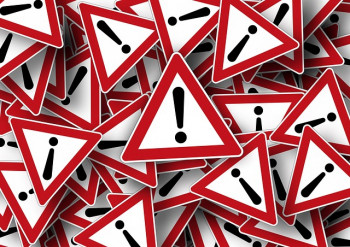 Mandatory information:
Mandatory information:
Floradix® with iron
Active substance: ferrous gluconate. Indications: In case of increased need for iron, if a risk of developing iron deficiency is evident. An increased iron requirement exists in particular in the case of increased iron loss, e.g. during menstruation. Furthermore, there is an increased need for iron during pregnancy and lactation as well as during the recovery period after illness.
Contains invert sugar and fructose. Please see package insert.
For risks and side effects, read the package leaflet and ask your doctor or pharmacist.
Direction for use:
Please follow the dosage instructions, otherwise FLORADIX® WITH IRON may not work properly.
Dosage:
Unless otherwise prescribed, Adults and adolescents 10 years of age and older take 15 ml 3 times per day using the enclosed measuring cup.
45 ml FLORADIX® WITH IRON contains 36.8 mg of usable iron(II).
Children from 6 to 10 years: 2 times 15 ml.
30 ml of FLORADIX® WITH IRON corresponds to 24.5 mg of iron(II).
Use is not intended for children under 6 years of age .
Method of administration:
Shake before use. It is best taken chilled ½ hour before meals.
Duration of use:
If you have any questions regarding clarification of the duration of use, please ask the doctor or pharmacist.
Note for diabetics:
15 ml corresponds to 0.3 BE.
 Salus herbal blood Floradix with iron, 500ml (green/pharmacy...
Salus herbal blood Floradix with iron, 500ml (green/pharmacy...  Salus herb blood Floradix with iron, 700ml (green)
Salus herb blood Floradix with iron, 700ml (green)  Salus herbal blood Floradix with iron, 500ml (green/pharmacy...
Salus herbal blood Floradix with iron, 500ml (green/pharmacy... 
 Double heart bile dragee with artichoke, 50 dragees
Double heart bile dragee with artichoke, 50 dragees  Hipp Combiotik 2 Follow milk without starch after the 6th month, 600g
Hipp Combiotik 2 Follow milk without starch after the 6th month, 600g  Bambinchen 1 infant formula based on goat milk, from birth on, 400g
Bambinchen 1 infant formula based on goat milk, from birth on, 400g  Double heart garlic capsules with mistletoe + hawthorn, 480 capsules
Double heart garlic capsules with mistletoe + hawthorn, 480 capsules 

 Hipp children's milk combiotik from the 1st year, 600g
Hipp children's milk combiotik from the 1st year, 600g 
 Salus herbal blood Floradix with iron, 500ml (green/pharmacy...
Salus herbal blood Floradix with iron, 500ml (green/pharmacy... 
 Doppelherz aktiv Magnesium 500 + B12, 30 Tablets, Food Supplement
Doppelherz aktiv Magnesium 500 + B12, 30 Tablets, Food Supplement 

 Doppelherz Knoblauch-Kapseln mit Mistel und Weißdorn, 270 Kapseln,...
Doppelherz Knoblauch-Kapseln mit Mistel und Weißdorn, 270 Kapseln,... 

 Salus herb blood Floradix with iron, 700ml (green)
Salus herb blood Floradix with iron, 700ml (green) 

 Double heart garlic capsules with mistletoe + hawthorn, 480 capsules
Double heart garlic capsules with mistletoe + hawthorn, 480 capsules  Salus Kindervital Drink with calcium and vitamin D3 for growth and...
Salus Kindervital Drink with calcium and vitamin D3 for growth and... 
